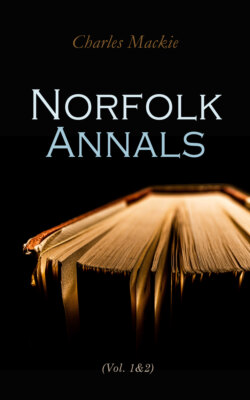Читать книгу Norfolk Annals (Vol. 1&2) - Charles Mackie - Страница 271
На сайте Литреса книга снята с продажи.
JULY.
Оглавление2.—Twelve smacks were despatched from Wells to a newly discovered oyster bed at Happisburgh, whence they returned on the following day with from 100 to 121 tubs each.
—*“Notwithstanding the clouds which lower on the landed interest, the sun of Holkham’s prosperity has shone forth with undiminished splendour,” was the comment which prefaced this year’s report of the Holkham Sheep Shearing. The business of the meeting commenced with an inspection in front of the hall “of the various processes in the manufacture (by the labourers’ children and the parish poor) of part of the crop of flax and hemp grown upon Holkham Park Farm in the last year. The several operations of breaking, heckling, and spinning were gone through by females of various ages with ease and facility.” Some of the sacks and sheeting manufactured from the materials were also shown. The gathering was attended by H.R.H. the Duke of Sussex, the Duke of Bedford, the Earl of Albemarle, Lord Erskine, Lord Crewe, Sir F. Burdett, Mr. Hume, &c. “The magnificent hospitality of these meetings congregated men from all parts of the civilized world. None but agricultural subjects were discussed. On these the most conflicting opinions were freely given and as freely canvassed, but anything political was excluded. And thus, although the political opinions of Mr. Coke and most of his personal friends were not only very decided, but for a great period, and that the most brilliant era of the Holkham meetings, unpopular with the great majority of those connected with the landed interest, yet men of every shade of political opinion were heartily welcome . . . and although they might hear some favourite theory of farming ridiculed they never would find anything hurtful to their political feelings advanced. The Sheep Shearing of 1821, indeed, was an exception. Political topics were then introduced. It was a bad omen. This Sheep Shearing was the last.”—“Journal of the Royal Agricultural Society,” Vol. XIV., part 1.
7.—Miss Biffin paid a return visit to Norwich, and was exhibited at St. Peter’s Steps, the Market Place.
19.—Norwich, in common with the cities and towns of the kingdom generally, celebrated the Coronation day of King George IV. The Mayor and Corporation went in procession to the Cathedral, preceded by a troop of the 9th Lancers, commanded by Capt. Campbell, sixty-four Waterloo men wearing their medals, and by the loyal and constitutional clubs with their flags. The procession was closed in by the Norwich Light Horse Volunteers. After service a roasted bullock, weighing 60 stones, was distributed in the Market Place, with 2,880 penny loaves, and several barrels of beer. There was a similar distribution in Ber Street. A dinner took place at St. Andrew’s Hall, under the presidency of the Mayor, and at night a display of fireworks was given on a staging erected on the south side of the Market Place. A very elaborate triumphal arch, erected near the Guildhall, was brilliantly illuminated. There were like demonstrations at Yarmouth, Lynn, and other towns in the county.
29.—Died at St. John Timberhill, Norwich, John Smith, schoolmaster, aged 54, “the author of several scholastic works and an English grammar.”
30.—A grand cricket match between the Holt and Nottingham clubs commenced at Holt, and was continued on the two following days. It terminated in favour of Nottingham, with ten wickets to spare—Nottingham, 150-154; Holt, 80-73. The Holt team included R. J. Brereton, Garwood, N. Pilch, William Pilch, F. Pilch, W. Englebright, R. Englebright, Frost, Brunton, Carmichael, and Goggs.
31.—The new river or Cut from King’s Lynn to Eau Brink was opened. At 8.30 a steam barge passed beneath the new bridge into the Cut, followed by a great number of boats. After the commissioners had viewed the work the steamboat returned to Lynn, where dinner was served at the Town Hall, under the presidency of Lord William Bentinck.
